Top Dry Cat Foods for Effective Weight Management
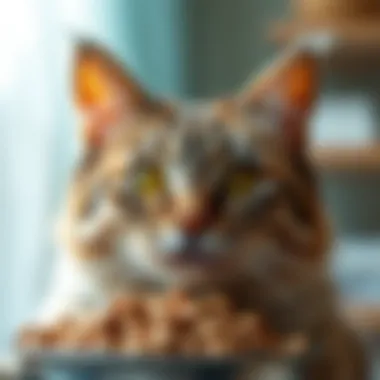
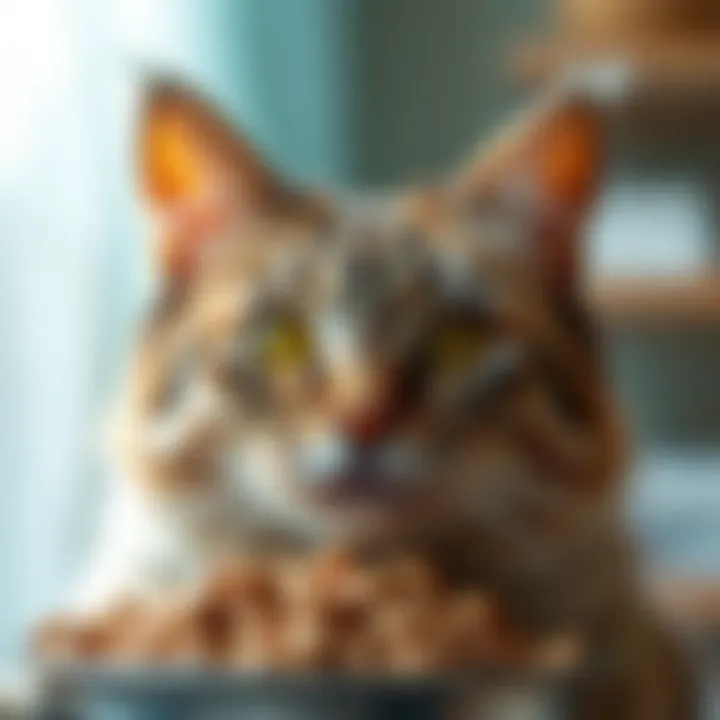
Intro
Maintaining a cat's ideal weight presents a significant challenge for many owners. The importance of weight management is highlighted by the increasing rates of obesity in felines, leading to a range of health complications. A crucial aspect of this management strategy revolves around the appropriate selection of dry cat food. This guide not only navigates through the maze of available food choices but also emphasizes critical nutritional factors essential for fostering a healthy lifestyle in your feline companion.
Understanding nutrition is less about fancy labels and more about knowing what your cat truly needs. Not all dry foods are created equal; some may even contribute more to weight gain than weight control. Here, we will uncover what to look for in ingredients and how to utilize feeding techniques to aid your cat's weight management journey. Through this exploration, all kitty owners can learn to cultivate a balanced diet for their furry friend, ensuring optimal health and longevity.
Pet Care and Grooming
Importance of Regular Care
A solid grooming routine dovetails nicely with dietary practices to help keep your cat in peak shape. Regular care, including brushing and check-ups, can signal any changes in health that might warrant a closer look. Not to mention, a clean cat is often more comfortable and happy, which encourages activity—important for maintaining a healthy weight.
Grooming Techniques by Pet Type
Different cat breeds have varying grooming needs. Long-haired varieties like Persians may require daily brushing to avoid matting, while short-haired breeds might only need it weekly. Tailoring your grooming approach helps keep fur off your furniture and reduces hairballs.
Tools and Products Recommendations
When selecting grooming tools, opt for a combination of:
- Slicker brushes for removal of loose hairs
- Flea combs if you live in an area prone to infestations
- Nail clippers, which should be a staple in any cat owner's toolkit
These tools streamline the process, making it easier for you and more enjoyable for your cat.
Seasonal Care Tips
Seasons can impact a cat's health and grooming regimen. In warmer months, brushing kicks up a notch to minimize shedding, while in colder months, skin hydration becomes crucial. Regular baths should be avoided unless recommended by a veterinarian, as overbathing can strip natural oils. Always tailor your cat's upkeep to the season, considering climate effects on dietary and grooming needs.
Health and Nutrition
Understanding Pet Nutrition
Nutritional balance should be the cornerstone of any weight management strategy. Your cat's food should primarily consist of high-quality protein, moderate fat, and minimal carbohydrates. Read labels carefully to ensure your choice matches this breakdown. Ingredients like whole chicken or fish should be at the top of the list, rather than fillers like corn or wheat.
Common Health Issues by Species
Many health concerns arise due to improper weight management, including diabetes, arthritis, and cardiac issues. Staying vigilant with regular check-ups can preemptively address these problems. Discuss your cat's weight and diet preferences with your veterinarian to create a tailored plan.
Preventive Care and Regular Check-Ups
Regular veterinary visits often include discussions around diet and exercise. Monitoring weight and any associated health issues allows for timely interventions. Small adjustments today can lead to significant differences down the road.
Food and Dietary Advice
When choosing dry cat food for weight management, some specific options to consider include:
- Royal Canin Feline Weight Care
- Hill’s Science Diet Perfect Weight
- Purina Pro Plan Weight Management
Keep in mind that transitioning to a new food should happen gradually to avoid digestive upset. Swap out a portion of the old food for the new over a week's time.
Behavioral Training
Basics of Positive Reinforcement
Strong evidence supports the value of positive reinforcement in training. Rewarding your cat for engaging in physical activity or following commands strengthens their behavior and forms a satisfying bond.
Training Techniques Users Can Apply
Utilizing clicker training can be an effective method for encouraging your cat to move more. Pairing commands with treats creates an association, motivating them to exercise while gaining mental stimulation.
Managing Behavioral Issues
Sometimes, weight gain can be attributed to emotional eating or boredom. Observing behavior can give insights into underlying issues. Changes in playtime or socialization may mitigate these concerns.
Importance of Socialization
Socializing your cat with other pets provides a unique form of enrichment, encouraging them to be active and dynamic. This can play a crucial role in their overall well-being and contribute to healthy weight management.
Engaging Activities and Enrichment
Fun Games to Play with Your Pet
Simple activities, such as interactive play with wands or lasers, can keep a cat engaged while burning off calories. Feather toys are a great way to mimic hunting instincts, leading to naturally high activity levels.
DIY Toys and Activities
Creating toys from household items is both economical and fun. A simple yarn ball or crumpled paper can captivate your cat. It's often the simplest things that spark joy!
Importance of Mental Stimulation
Keeping your cat’s mind sharp is equally as vital. Puzzle feeders, designed to dispense food as your cat figures things out, not only slow down their eating but also engage their intellect.
Outdoor Adventures and Exploration
If safe to do so, introducing your cat to the outdoors can heighten their activity levels. Consider utilizing a harness and leash, ensuring the environment is secure, allowing your cat to explore safely.
Resources and Community Engagement
Recommended Books and Websites
To better educate yourself, consider checking out resources like:
- American Association of Feline Practitioners
- The Indoor Pet Initiative
These are solid starting points for trustworthy information.
Forums and Groups for Pet Owners
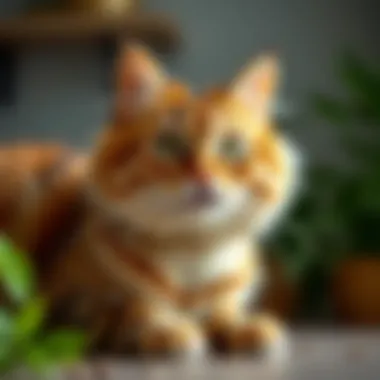
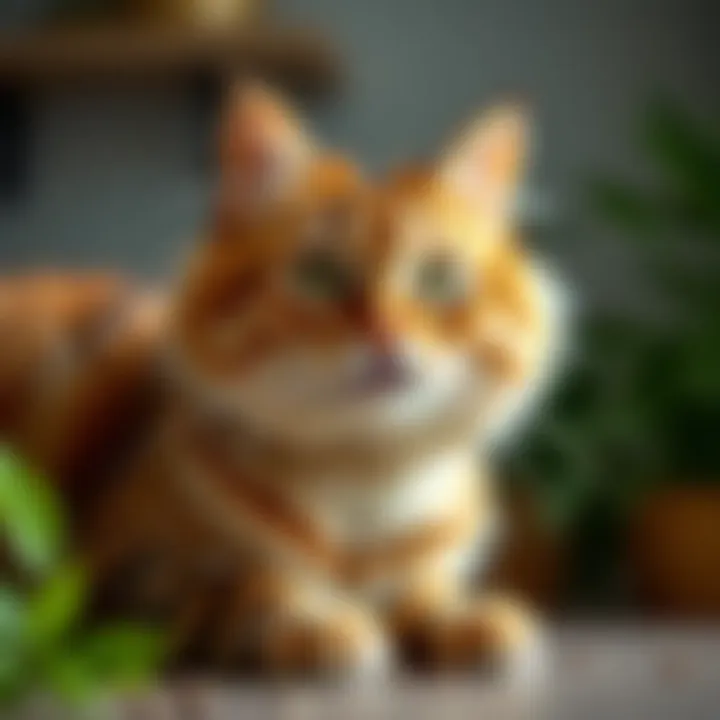
Engaging with other cat owners through online forums or local groups can be an invaluable source of support. Discussion can help you gather insights from those who’ve been through similar journeys.
Finding Local Services and Classes
Look for local grooming services or training classes that focus on weight management. Having experienced guidance can simplify your efforts and enhance understanding.
Encouraging Community Sharing and Contributions
Utilizing platforms like Reddit can open windows for sharing your experiences or finding new tips from others in similar situations. Community engagement often leads to more informed decisions and added support in addressing your pet’s needs.
Understanding Feline Obesity
Feline obesity is not just a cosmetic issue; it’s a pressing health concern that can lead to a cascade of physical problems for cats. Understanding this condition is crucial for cat owners who want to promote long-term health and well-being for their feline friends. When we talk about felines being overweight, we are not simply considering their appearance but also evaluating how excess weight impacts their mobility, their overall quality of life, and even their lifespan.
Obesity in cats can lead to serious health complications. Life expectancy may drop significantly when a cat is significantly overweight. Hence, making informed choices about their diet and exercise is paramount. In this article, we’ll cover the various aspects of feline obesity, including the causes, health risks, and the vital role that quality dry cat food can play in effective weight management.
Defining Obesity in Cats
So, what exactly qualifies a cat as obese? Many veterinarians rely on the Body Condition Score (BCS), which charts a cat’s weight against their size and breed. A score ranging from 1 to 9 typically informs this assessment. Generally, cats with a score of 6 or higher are considered overweight, while those scoring 8 or 9 are deemed obese. It’s essential for cat owners to recognize that maintaining a healthy weight directly influences a cat's energy levels and overall health.
Common Causes of Weight Gain
Understanding the triggers behind weight gain in cats is vital in preventing and managing obesity. The following points highlight the more common causes:
Genetic influences
Genetics plays a significant role in determining a cat's susceptibility to weight gain. Certain breeds, like the British Shorthair or the Ragdoll, are predisposed to gaining weight due to their metabolic rates and body composition. This knowledge is valuable, as cat owners can be more vigilant about monitoring their pet’s weight and adjusting their diets accordingly. Thus, understanding genetic predisposition can act as a safeguard against obesity, pushing owners to take proactive measures.
Sedentary lifestyle
Most feline companions enjoy lounging around; their natural hunting instincts often remain unexercised in a home environment. A sedentary lifestyle can lead to weight gain, as calories consumed typically surpass the energy burned. Planning interactive playtimes and providing stimulating toys increases physical activity, encouraging cats to shed excess weight. The benefits are twofold: not only does it prevent obesity, but it also enriches the cat's life.
Overfeeding
It's often said, 'a little love goes a long way,' but when it comes to feeding cats, sometimes that 'love' manifests as overfeeding. Cats may appear to be perpetually hungry, which can lead owners to misunderstand their dietary needs. Using treats as a form of affection can backfire, leading to an unintentional overabundance of calories. Keeping an eye on serving sizes and adhering to veterinarian recommendations can keep feline friends from tipping the scales unhealthily.
Poor nutrition
The quality of food fed to cats directly correlates with weight gain. Low-quality cat foods often contain high levels of fillers and empty calories. Consequently, cats consuming such diets may not receive the nutrients they need, leading to increased hunger and subsequent overeating. Choosing nutritionally balanced food tailored for weight management can shield against this issue, providing enough nourishment without excess calories. This aspect cannot be overlooked; a quality diet is foundational in maintaining a healthy weight.
Health Risks Associated with Obesity
Obesity is far from being just a cosmetic concern. It leads to a myriad of health issues that can drastically affect a cat’s life. Addressing these risks is part and parcel of understanding the gravity of obesity in our feline companions.
Diabetes mellitus
One of the most significant health risks associated with obesity in cats is diabetes mellitus. This condition arises when insulin production is compromised due to excessive fat. As a result, the cat's body struggles to regulate blood sugar levels, leading to serious health complications. Maintaining a healthy weight can help mitigate this risk, emphasizing that dietary choices and controlled feeding can promote better overall health.
Joint problems
Extra weight puts excessive stress on a cat's joints, possibly leading to conditions such as arthritis, which can cause severe pain and limit mobility. By keeping their weight in check, cat owners can help prevent the premature wear and tear on those vital joint structures, ensuring their furry companions remain agile and playful throughout their lives. It's a vital aspect that must not be ignored, as mobility directly affects a cat’s quality of life.
Heart disease
Lastly, the weight problem can escalate into cardiovascular issues. Obese cats face a higher risk of heart disease, as increased body fat can lead to hypertension and other heart-related complications. Being proactive about diet and weight management decreases these risks substantially; thus, investing in quality dry cat food can be a life-changing choice for many cats.
Remember, maintaining a healthy weight is essential for longevity and quality of life in cats. Paying attention to what and how much they eat is key to preventing obesity-related health complications.
Importance of Weight Management
Weight management is not just a matter of aesthetics for our feline companions; it is crucial for their overall health and longevity. When cats maintain an ideal weight, they experience numerous benefits that significantly enhance their quality of life. Here, we will discuss the specific elements that highlight the importance of weight management in cats, including longevity, improved quality of life, and reduced veterinary costs.
Enhancing Longevity
A cat's lifespan can be heavily influenced by their weight. Overweight and obese cats are more prone to a myriad of health issues that can shorten their lives. When a cat maintains a healthy weight, they are less likely to suffer from chronic conditions such as diabetes or arthritis. Weight management contributes to a more active lifestyle for cats, allowing them to engage in natural behaviors that are crucial for their mental and physical health.
Studies show that cats with healthy weights can live longer, with some research indicating a potential life extension of up to two years compared to their overweight peers. This longevity is often linked to better organ function and mobility, enabling cats to enjoy their golden years without the debilitating effects of obesity.
Improving Quality of Life
Beyond just living longer, maintaining a healthy weight significantly improves a cat's quality of life. Cats that are at an ideal weight are generally more energetic and agile. They can climb, run, and play, allowing them to engage in activities that stimulate their instincts and keep them mentally sharp. Additionally, a healthy weight reduces the risk of discomfort that often comes with excess weight, like joint pain or respiratory issues.
This affirmation of well-being extends to their behavior as well. Cats that feel good are often friendlier and more interactive with their owners, forging a deeper bond. Investing in weight management not only promotes health but also enriches the day-to-day interactions between cats and their humans.
Reducing Veterinary Costs
Healthcare expenses can add up quickly, especially if a cat develops weight-related health issues. By effectively managing a cat's weight, pet owners can potentially save a significant amount on veterinary bills. Preventative care, such as regular check-ups and a well-balanced diet, is often far less expensive than treating chronic illnesses that could arise from obesity. Pushing preventative health is not just an act of love towards our pets—it’s a financially wise move too.
Characteristics of Quality Dry Cat Food
Choosing the right dry cat food involves understanding several key characteristics that contribute to feline health and weight management. With an overwhelming array of options on store shelves, it’s essential for cat owners to recognize what makes dry food truly suitable for their pets. Quality ingredients, proper nutritional balance, and suitability for the cat's life stage should guide decisions in this area.
Nutritional Balance
In any discussion about cat food, nutritional balance holds a significant place. This means that a cat's dietary requirements need to be fulfilled through the food provided. Felines require a blend of protein, fats, and carbohydrates to sustain their energy levels and maintain a healthy weight.
Protein content
When it comes to protein, high-quality sources are paramount. Cats are obligate carnivores, meaning they require a diet rich in protein derived from animal sources.
- Key characteristic: The primary benefits of protein are numerous; it aids in muscle development, fur health, and overall metabolic function.
- Unique feature: Whole meats such as chicken or fish should be prominent in the ingredient list rather than meat by-products, which tend to have less nutritional value. Dry foods containing at least 30% protein are generally considered beneficial in supporting healthy weight management, promoting lean muscle while reducing excess fat.
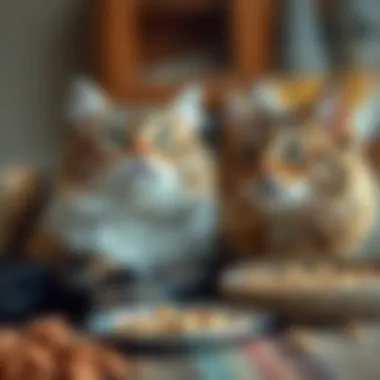
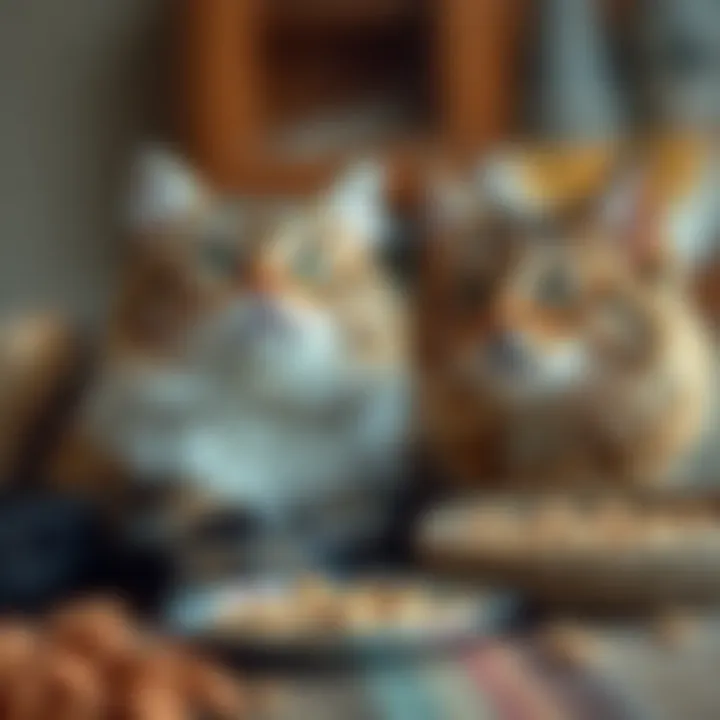
However, protein content must be paired with other components to maintain balance.
Fat levels
Fats are often mistakenly viewed as detrimental in any weight management discussion. However, they are essential for providing energy, supporting skin health, and aiding in the absorption of fat-soluble vitamins.
- Key characteristic: Healthy fats, such as Omega-3 and Omega-6 fatty acids, can positively impact a cat's wellbeing.
- Unique feature: Foods with moderate fat levels (ideally around 10% to 15%) ensure energy but should not be excessive, as high fat can contribute to weight gain. The right type of fat improves overall coat health and can even enhance metabolism.
Fiber inclusion
Fiber is another critical component in dry cat food, particularly for overweight or sedentary cats. While fiber does not provide energy like protein or fat, it enhances digestion and can aid in weight management.
- Key characteristic: It helps cats feel full longer, reducing the likelihood of overfeeding.
- Unique feature: Look for foods containing fiber sources like beet pulp or psyllium, as these can support digestive health. Many quality diets include around 5% to 10% fiber to help maintain regular bowel movements and weight control. However, excessive fiber can be counterproductive and lead to digestive upset.
Ingredient Quality
Ingredient quality plays a major role in determining the efficacy of dry cat food. Not all ingredients contribute equally to a cat’s nutritional needs; hence, scrutinizing the list can make a world of difference in dietary outcomes.
Whole meats vs. by-products
When it comes to the protein source, the distinction between whole meats and by-products is crucial. Whole meats like chicken or beef should ideally be the first ingredient, as they supply essential amino acids needed for cat health.
- Key characteristic: Whole meats promote better health outcomes, providing superior nutrients compared to less-desirable by-products, which can be less digestible.
- Unique feature: By-products might include animal parts not typically consumed by humans, which can lead to nutritional gaps in a cat’s diet.
This is why understanding what goes into the food can save owners from potential pitfalls in their pet's nutrition.
Grain-free vs. grain-inclusive
The debate between grain-free and grain-inclusive diets continues, each has its advantages and disadvantages. Grain-free options are often regarded as more natural, mimicking a cat’s ancestral diet.
- Key characteristic: Usually these foods replace grains with legumes or potatoes, which can be easier on a cat's gastrointestinal tract.
- Unique feature: While some cats do indeed thrive on grain-free diets, the reality is many can digest grains, and these can provide essential nutrients and fibers too. Thus, evaluating a cat’s unique needs should dictate the grain choice in their diet.
Life Stage Appropriateness
Cats have different nutritional requirements based on their life stage. Cats, like people, undergo changes that can drastically affect their dietary needs. Lack of consideration in this area can lead to unwanted health issues.
Kittens
The dietary needs of kittens are critical for their growth and development. Kitten food is intended to provide more calories, proteins, and fats than adult cat food.
- Key characteristic: The accelerated growth phase needs a higher caloric intake and optimum protein levels to promote healthy muscle development.
- Unique feature: A kitten’s diet should typically have around 35% protein and a higher fat content to fuel their playful, energetic nature.
Adult cats
For adult cats, the focus shifts to maintaining a healthy weight and overall health. Formulating a balanced diet with proper portions is essential in this stage.
- Key characteristic: Adult cat food is designed to provide maintenance rather than growth, with balanced nutritional levels to support a healthy weight.
- Unique feature: Products formulated for weight management often indicate fewer calories, ensuring that cats can enjoy their mealtime while staying under a calorie budget.
Senior cats
As cats age, their metabolism typically slows down, necessitating a shift in their dietary intake. Senior cat food often contains lower calories but is packed with essential nutrients and supplements for joint health and cognitive support.
- Key characteristic: The emphasis should be on preserving muscle mass while reducing excess fat.
- Unique feature: Many senior formulations include glucosamine and other supportive components to maintain an active lifestyle into old age.
When in doubt about your cat's dietary needs, consult with a veterinarian. They can offer personalized insights and recommendations to ensure your feline companion stays healthy and happy.
Learn more about feline nutrition from relevant resources like Wikipedia and American Veterinary Medical Association.
Top Brands for Weight Management Dry Cat Food
Choosing the right brand of dry cat food for weight management is crucial for feline health. Each brand offers distinctive formulas tailored to weight control, with various ingredients and nutritional values that cater to different cat needs. By exploring top brands, cat owners can make informed decisions that not only aid in managing weight but also contribute to overall well-being.
Brand A Overview
Product highlights
Brand A has carved a niche in the market for its remarkable focus on ingredients that foster weight management. What sets this product apart is its use of real meat as the primary ingredient, ensuring adequate protein levels without excess fat. This characteristic is key in helping cats maintain lean muscle while simultaneously shedding unwanted pounds. Additionally, Brand A includes protein-rich legumes; these not only provide essential fibers but also promote a feeling of fullness in cats, reducing the chances of overfeeding. The balance of flavors offers a tasty alternative that keeps picky eaters satisfied.
Nutritional analysis
In the realm of nutritional analysis, Brand A exhibits a striking transparency in its formulation. The guaranteed analysis provided on the packaging offers data such as crude protein, fat, fiber, and moisture percentages, allowing pet owners to understand exactly what’s going into their cat's diet. This brand typically contains 30% protein, which is beneficial for maintaining muscle mass, while the fat content remains regulated, often around 10-15%, keeping calorie counts in check. This unique blend allows pet owners to confidently consider this brand as a promising option for weight management.
Brand B Overview
Unique features
Brand B stands out owing to its specialized formulas for specific life stages. The brand offers tailored recipes, whether your cat is a playful kitten or a wise elderly feline. By adjusting the ratios of protein, fat, and carbohydrates, it ensures that each life stage is catered for, thus promoting better overall health. This rational allocation toward different ages is especially noteworthy, as it makes this brand a compelling option for households with multiple cats of varying ages.
Targeted audience
The targeted audience for Brand B primarily includes cat owners looking for holistic options. Therefore, it appeals not just to those managing weight, but also to pet parents who prioritize natural and organic ingredients. With an emphasis on non-GMO components, Brand B underscores its commitment to wholesome feeding. The focus on eco-friendly practices in sourcing and packaging may also resonate with environmentally conscious consumers, providing both health and ethical advantages.
Brand Overview
Customer testimonials
When it comes to Brand C, customer testimonials reveal a pinnacle of satisfaction and trust. Many pet owners express delight at how their cats have transitioned to a healthier weight and improved their energy levels after switching to this brand. The palatability of the kibble has earned it numerous accolades, with several reviews highlighting that even the fussiest eaters enjoy it. These testimonials reflect a shift not only in body weight but also in overall vitality, making Brand C a noteworthy candidate in the weight management category.
Expert recommendations
Additionally, Brand C holds significant sway among veterinarians and pet nutritionists alike, often being featured in expert recommendations. Many professionals advocate for this brand due to its meticulously designed formulas that balance low-calorie density with high nutritional value. Being consistently noted for its use of quality municipal ingredients such as salmon, chicken, and a variety of vegetables, Brand C assures pet owners of optimum health benefits, giving them peace of mind as they strive for their cat's well-being.
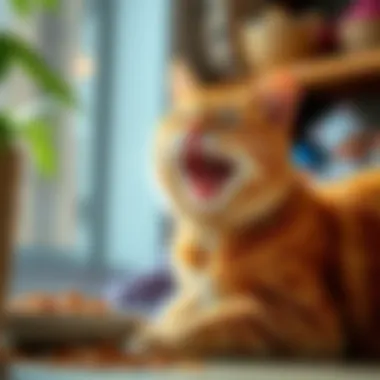
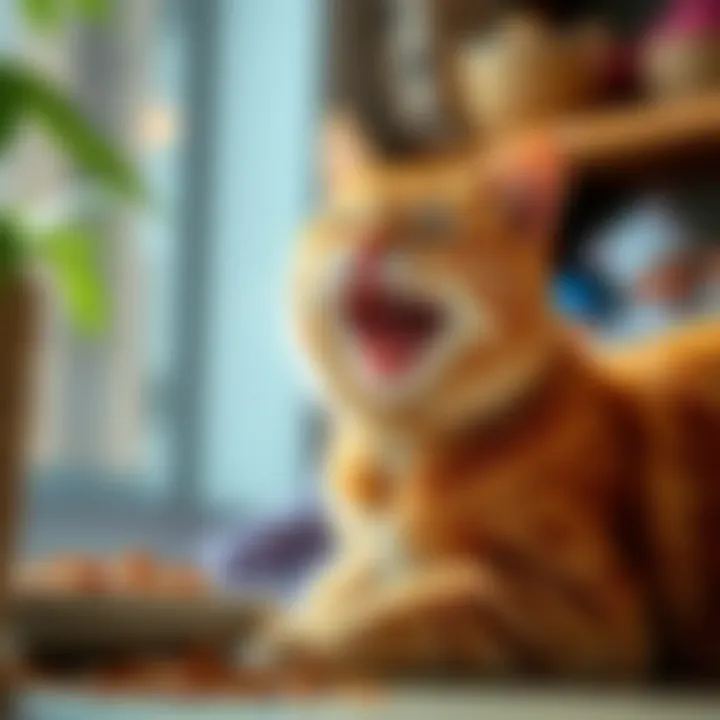
"Selecting the right dry cat food can be a game changer in weight management, impacting both health and happiness of your feline companions."
Through exploring reputable brands, cat owners can equip themselves with the knowledge necessary to make better choices, leading to healthier, happier felines.
Reading Cat Food Labels
Understanding how to read cat food labels is crucial for any cat owner looking to manage their pet’s weight effectively. Labels provide essential insight into the food's composition, helping you make informed choices. When it comes to managing your cat's weight, deciphering these labels can mean the difference between a healthy diet and an unhealthy one.
Key elements to pay attention to include the ingredient list and the nutritional information, both of which shine a spotlight on what exactly is going into your cat's diet. This knowledge empowers owners to choose foods that meet their cat’s specific dietary requirements, promoting overall health and vitality. But let’s dig a bit deeper into the specifics of what these labels entail.
Understanding Ingredients List
The ingredients list is like a roadmap to what you're feeding your feline friend. The listing must start with the most significant component by weight, usually the protein source, such as chicken or fish. This prioritization gives you a clue about the food's quality.
- Whole Meats vs. By-Products: Whole meats should ideally top the list. Meats labeled as "by-products" sometimes refer to less desirable parts of the animal. This distinction is crucial.
- Grain Free vs. Grain Inclusive: Some cats do best on grain-free diets, especially those with allergies or sensitivities. Others thrive on diets that include grains, as they may provide necessary fiber. You have to know your cat’s needs to navigate these choices properly.
Opting for dry cat food that lists high-quality ingredients can help maintain a healthy weight. Always keep in mind that higher-quality ingredients often mean enhanced nutrition and less overall feeding is necessary.
Interpreting Nutritional Information
Understanding the nutritional information can be a bit of a puzzle, especially with terms like guaranteed analysis. However, once you get the hang of it, it plays a pivotal role in deciding which food offers the best benefits.
Guaranteed Analysis
The guaranteed analysis provides a percentage breakdown of key nutrients: protein, fat, fiber, and moisture content. This information acts like a nutritional benchmark for comparison.
- By knowing the protein and fat content, you can assess if it aligns with your cat's weight management goals.
- A food high in protein but low in fat can support weight loss while retaining muscle mass.
However, rely on this data with caution. It's easy to be misled because this analysis does not reflect the quality or digestibility of the ingredients. Evaluating them along with ingredient sources is necessary for clarity.
AAFCO Standards
The Association of American Feed Control Officials (AAFCO) sets standards that ensure the food meets certain nutritional profiles. Products bearing the AAFCO statement guarantee that they are formulated to meet or exceed the basic nutritional needs for a specific life stage.
- This fact lends credibility to the brand and reassures cat owners about the food’s reliability.
- However, not all brands voluntarily comply with AAFCO standards, so it’s wise to check if your chosen food does.
Establishing Feeding Guidelines
Establishing feeding guidelines is akin to laying down the foundation of a solid house. When it comes to managing your cat's weight effectively, the approach to feeding not only shapes their health but also influences their behavior and overall wellbeing. It’s integral to ensuring that our feline companions remain in tip-top shape, preventing the myriad of health concerns that obesity can invite.
Determining Portion Sizes
Determining portion sizes for your cat’s meals requires a keen understanding of their specific needs. These needs can vary greatly based on factors such as age, breed, activity level, and health conditions. For instance, a sprightly young kitten might need a larger portion compared to a senior cat who prefers a more sedentary lifestyle.
When considering portion sizes:
- Consult Feeding Guidelines: Often, the packaging of dry cat food provides recommended serving sizes tailored to different weights and life stages. These figures should serve as a starting point.
- Monitor Your Cat’s Weight: Keep an eye on your cat's weight and adjust accordingly. If your cat is packing on the pounds, cutting back slightly on the portions is a sensible strategy.
- Use Measuring Tools: Instead of eyeballing it, use a measuring cup or scale to ensure you’re metering out the right amount.
The general rule of thumb is maintaining a balance. Too much food can lead to weight gain, while too little can leave your cat malnourished. The goal is to find that sweet spot where they feel satisfied but not overstuffed.
Frequency of Feeding
Establishing how often to feed your cat is equally critical. Cats, being natural hunters, often prefer smaller meals throughout the day rather than a couple of large feasts. Many pet owners have adopted the practice of feeding their cats multiple times a day, which aligns better with their instinctual behaviors. Here’s what to consider:
- Three to Four Meals a Day: This frequency mimics their hunting pattern and can help regulate their metabolism. If you’re trying to manage weight, you might divide the daily intake into smaller, more manageable meals.
- Self-Feeding Options: For some, using an automatic feeder can be a practical solution, allowing cats to nibble throughout the day while preventing overindulgence at every meal.
- Watch for Changes: Pay attention to signs that may indicate your cat isn't satisfied, like begging or pursuing you when you’re in the kitchen. Adjust feeding frequency if needed, making sure not to let lazy habits creep in.
Remember, when in doubt, consult your veterinarian for tailored advice that meets your cat’s unique needs.
Complementary Strategies for Weight Management
Maintaining a healthy weight for your feline friend goes beyond selecting the right dry food. While proper nutrition lays the groundwork for weight management, complementary strategies can reinforce those efforts and help your cat shed those extra pounds. These approaches not only enhance the effectiveness of the chosen diet but also contribute positively to your cat’s overall wellness.
Encouraging Exercise
Exercise is a pivotal element in a cat’s weight management plan. Just like humans, cats need to burn calories to maintain a healthy weight. Feline exercise might not look like your usual gym routine, but engaging your cat in play helps keep those extra pounds at bay.
- Interactive Toys: Toys that encourage your cat to chase, pounce, and jump can bring a burst of activity into their life. Think about cat lasers, feather wands, or even automated toys that mimic the movements of prey.
- Engaging Environments: Creating a stimulating environment can spark your cat's natural instincts to explore. Consider adding climbing trees or tunnels that encourage movement.
- Scheduled Playtime: Designate specific times each day for play. Regularity builds a habit, and your kitty will learn to look forward to it. Even 15-20 minutes twice a day can make a huge difference.
By mixing things up and introducing various activities, you can keep your cat interested and active. As they say, a tired cat is a happy cat, and the benefits of interactive play extend beyond weight management.
Monitoring Progress
Keeping track of your cat's weight and overall health is crucial in any weight management plan. Regular monitoring not only helps you assess the effectiveness of your chosen dry food but also provides insights into how your cat's lifestyle impacts their well-being.
- Weighing Regularly: Schedule weigh-ins every couple of weeks. Use a reputable scale; if your cat can sit still, weigh them in your arms first, then again without the cat to find their weight.
- Body Condition Scoring: Familiarize yourself with body condition scoring (BCS) systems. These systems help assess your cat’s physique, giving you a clear picture of whether they are at an ideal weight or need adjustments in diet or activity. The scale usually ranges from 1 (emaciated) to 9 (obese).
- Veterinary Visits: Regular check-ups with your veterinarian can provide valuable insights into your cat's health progress. They can recommend adjustments based on age, breed, or preexisting issues that might affect weight.
Regularly monitoring your cat's weight and health can prevent the risk of obesity-related issues, ensuring a longer, happier life for your furry companion.
By combining effective feeding practices with encouragement for exercise and careful progress tracking, you create a holistic approach to managing your cat's weight. With commitment and a bit of creativity, maintaining a healthy lifestyle for your feline friend can be both effective and rewarding.
Consulting with Veterinarians
When it comes to managing your cat's weight, consulting with veterinarians is crucial. These professionals offer invaluable insights that transcend general advice available on the internet. They not only boast extensive knowledge about feline health but can also provide tailored recommendations suited to your cat’s unique needs. Their education equips them to navigate the complex world of pet nutrition, making them essential allies in your weight management journey.
Seeking Professional Advice
The decision to consult a veterinarian should never be taken lightly, especially concerning weight management. A vet can assess your cat's specific condition, including age, breed, and any pre-existing health issues. This assessment often involves a thorough examination, blood tests, and sometimes even body composition analysis. The findings will help determine an appropriate diet plan and any necessary lifestyle changes. For instance, your vet might recommend specific brands or types of dry food that suit your cat’s needs based on the gathered data.
Additionally, they may suggest complementary strategies, such as adjusting feeding routines or incorporating more engaging activities into your cat's day. These tailored recommendations can significantly improve your feline's quality of life and overall well-being. It is essential to remember that what works for one cat may not necessarily work for another. Hence, individual assessments are imperative.
Regular Health Check-Ups
Monthly or biannual vet visits help ensure your cat’s continuing health. Regular health check-ups not only track weight loss or gain but also identify any barking issues early on. Because cats tend to hide their discomfort well, routine visits allow for early detection of potential conditions unnoticeable to the untrained eye.
During these visits, your vet will monitor your cat’s weight, consult on dietary adherence, and adjust feeding plans as necessary. This ongoing relationship helps create a proactive approach to weight management. Always keep in mind that managing a cat’s weight is not just a short-term goal; it is about fostering a lifestyle that promotes long-term health.
Always consult your veterinarian before making significant changes to your cat's diet or exercise routine. They can guide you through the nuances of pet nutrition and health monitoring.















